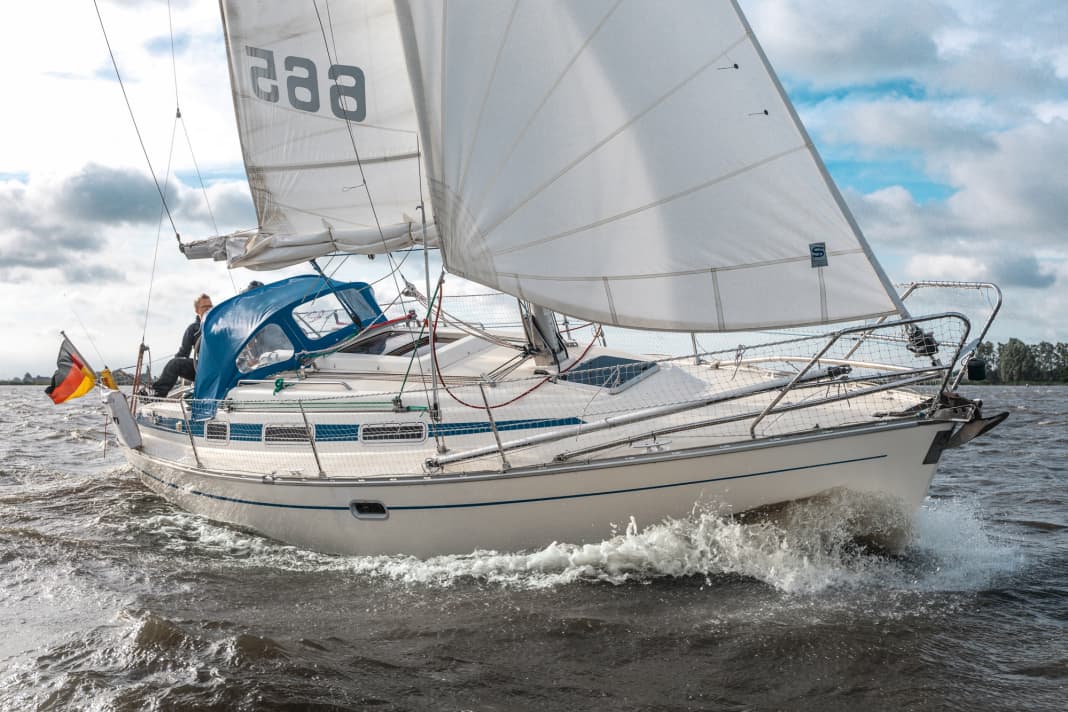





- Used boat profile
- Also good: three alternatives at a glance
- Model history and market
- The measured values for testing the Bavaria 30 Plus
- The Bavaria 30 Plus in detail
- Price and shipyard
- YACHT rating of the Bavaria 30 Plus
- Keep your eyes open when buying Bavaria
- Video of the Bavaria 30 Plus
Admittedly: Starting the test of a Bavaria with a story about a Dehler may seem strange. In this case, however, it makes perfect sense. After all, in 1992 Dehler was the largest German shipyard and therefore the market leader.
The Duetta 94 was now called the Dehler 31 and had the option of a wheel in the cockpit in addition to the tiller. And two separate cabins below deck with a total of four fixed berths. She also sailed sportily, and the shipyard had acquired a certain pedigree in terms of the sailing characteristics of the yachts through various successes on the regatta circuit. If Bavaria wanted to be a new shipyard in the country, it had to produce something sporty that also had all the characteristics of a typical yacht. At the same time, it had to remain affordable and easy to handle, as they also knew in Giebelstadt.
Used boat profile
- Type: Bavaria 30 Plus
- Designer: J&J Design
- Built: 1993-1996
- Quantity: unknown
- New price: 63,400 euros
- Used price current: 30-49,000 euros
As of 01/2024, how the prices shown are defined can be found here!
It was no easy task for Bavaria to assert itself against the top dog Dehler. Until then, the German designer Axel Mohnhaupt had designed the Bavarias. The well-known designs included the 300, 320, 340 and 350. The entry-level model at the time was the 30, which was then supplemented by the 30 Plus in the programme.
At the same time, this was no longer drawn by Mohnhaupt, but by the Slovenians from J&J Design, who milled the so-called plug, i.e. the positive mould, and were able to produce the moulds for the lamination work on top of it. This was both practical and cost-effective. And J&J drew quick designs that were easy to build with comparatively few labour hours. The ship was given a rather sporty 7/8 rig and was somewhat narrower and lighter than the old 300, but also larger and more expensive than the 30 offered at the same time without the "Plus" suffix.
The 30 cost around 90,000 marks, while the 30 Plus was offered from 124,000 marks. It was longer and had two separate compartments. The foredeck of the normal 30 was open to the saloon. In order to compete with the Dehler 31, a version with a steering wheel was offered. Bavaria thought it was well positioned to at least annoy the competition from Sauerland. It is impossible to say today whether this was successful, as Bavaria does not know how many 30 Plus were built; at the time, no value was placed on such numbers. However, the 30 Plus probably doesn't come close to the 500 or so Dehler 31s that were built. A look at the marinas shows this, as it is rarely represented there. A pity, because the package is actually a good one.
Everything there - in small
There was a choice of draught between 1.05 and 1.45 metres. Furthermore, the 9.25 metre hull length was to accommodate everything that belongs on a yacht: two cabins, saloon, galley, navigation table and wet room. To anticipate this: This only worked out reasonably well. Everything is there, yes - but everything is a bit too small. A few examples: The headroom under the companionway is just 1.76 metres, and the height above the inner aft berth is only 25 centimetres. However, this is also only 1.80 metres long, and the three doors are each only 36 centimetres wide.
This quickly makes claustrophobic people feel uneasy. Wearing a lifejacket in the wet room? Impossible. In short: the ship looks like a version of a yacht that has been washed too hot. That may sound harsh, but anyone interested in such a Bavaria must realise that the important comfort dimensions are small. If you are not a tall person, this may well be enough, but if you are over 1.75 metres tall, it will be uncomfortable below deck.
Also good: three alternatives at a glance
There are several used boats around 30 feet that cost around 35,000 euros. We briefly present three of them:
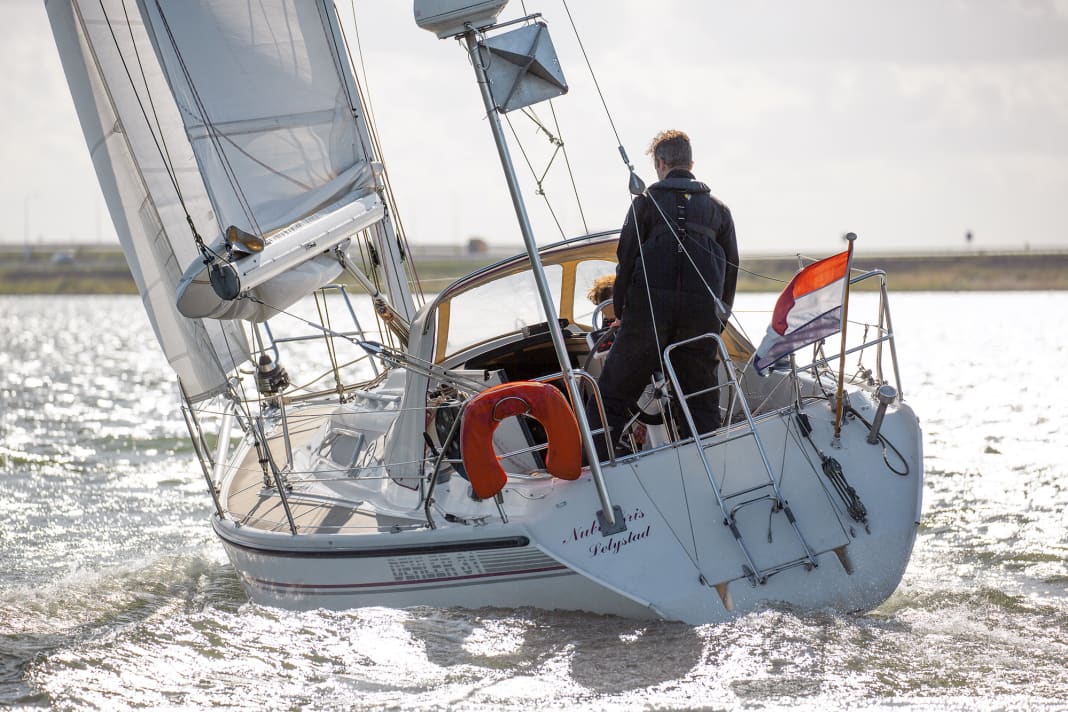



However, in harbours where the boat is allowed to protrude slightly beyond the box, the Bavaria fits into a convenient nine by three metre berth. What's more, the galley, sat nav and wet room work perfectly, everything is there. And pleasingly well finished. Lots of solid wood and lavish panelling testify to a very high standard of quality. At the time, Dehler was dominated by deep-drawn plastic below deck. The Bavaria 30 Plus, on the other hand, has a very ship-like appearance.
There is storage space wherever possible, and there are several cupboards. Unfortunately, the hatches in the galley open upwards, making it difficult to see inside. However, this is not necessary, as the contents fall out readily when you open them. The owner of the test boat is not bothered by any of this: "We were looking for a safe and handy boat for our family. The four of us enjoy relaxed family holidays on board. And the shallow draught of one metre is ideal, as we prefer to stay indoors in Friesland with the children while they are still small."
Safe despite high winds
The Bavaria, which sailed on the waters around Berlin before coming to the Netherlands, has probably rarely experienced conditions like those on the test day: a full 6 Beaufort, gusting up to 7. The waves are small on inland waters, but the gusts are all the more violent. And that's where the shallower draught really makes itself felt: If a pusher hits the rig, the Bavaria heels away immediately. The rudder pressure increases slightly, but it was never enough for a sun shot. On the contrary: it would have felt like there was more sail area, but in a used boat test it is never clear how old the rigging and the sails really are. In this respect, don't overdo it and ruin the owner's boat.
Better sailing with a tiller
The impression that the Bavaria leaves behind is good despite its short keel: although it lays down quite a bit on the cheek, partly due to the rather blown-out sails, it then sets off nicely. After all, three tonnes of weight is not a lot. She remains easy to control at the helm. Thanks to the 7/8 rig, the backstay can be used to take out a lot of pressure. With one hand on the mainsheet to release it quickly if necessary, everything feels very safe and controlled. While the mainsail can be operated by the helmsman behind the wheel using a curry cleat on the coachroof, the headsheets are out of reach.
It is therefore only really suitable for single-handed sailing with a tiller, because then the helmsman can also drive the foresail. The tiller is the better choice anyway, as the space behind the wheel is very tight. It is impossible to find a comfortable steering position. In addition, a tiller would simply be folded up in the harbour and would therefore be out of the way. But the steering column remains. And somehow gets in the way. The raised seating position aft in the centre is of little help when steering - from there, only sitting giants can see over the sprayhood. The wide coaming, on the other hand, would undoubtedly offer sensible sailing positions with the tiller boom in hand.
However, an important safety aspect is that you never have to leave the cockpit, everything is redirected there. This makes it difficult to operate at times, but that is only a question of higher-quality fittings. What is annoying, however, is the sprayhood. It gets in the way of both the winches on the coachroof and those on the coaming, resulting in ratchet-like back and forth movements. The sail areas are manageable, so this is perfectly feasible, but a free turn of the crank for the foresheet speeds up manoeuvres enormously. In view of the special conditions, the Bavaria 30 Plus makes a solid impression under sail. At no time, not even in the strong gusts, does a feeling of insecurity arise. You are and remain in control of the situation. At the same time, the boat starts up immediately and provides a lot of sailing pleasure. That's fine. A model with a deep keel is certainly even more fun. You definitely want to try it out. And here's a tip for the boat: if you can afford it in terms of sailing area, you should choose the version with a deep fin, which will certainly reduce the drift on the wind considerably.
Good substance, few flaws
Bavarias are basically solidly built, and the 30 Plus is no exception. However, there are weaknesses in some areas. For example, hairline cracks were frequently visible in the gelcoat on the deck of the test boat, particularly in the area of the railing feet. The foot railing, which is bolted through the hull and deck, is also prone to leaks. The aft end fittings appear to be particularly sensitive points. The test boat also showed slight water ingress in the aft chamber. The mast base and the feed-through of the inboard jetties also appear to be susceptible to leaks, as can be read in the forums of the owners' clubs. However, the jetties are very solidly connected to the hull further down. So the stability is not in question, it's just about the tightness of the deck.
However, the cracks in the area of the rear keel bolt on the test ship are critical. Here, a flange surface of the strongback to the hull is cracked. However, the damage is by no means typical for this type of boat; it can occur in any boat with a bolted keel.
If you can live with the rather small comfort dimensions, you will find a fully-fledged yacht that sails safely and agilely and is well finished. The stainless steel parts on and below deck, for example, are remarkably generously dimensioned. The woodwork is also solid. This undoubtedly also applies to the deck and hull. Leakages that occur after almost thirty years can all be managed with a little craftsmanship.
Model history and market
The Bavaria 30 Plus was built from January 1993 to December 1996. There were no model versions, only the difference between the deep and the shallow keel and with tiller or wheel. Yanmar or Volvo engines were installed. The Volvo MD 2020 had dual-circuit cooling and three cylinders, while the Yanmar two-cylinder engine was directly cooled. Although dual cooling circuits mean a longer service life, the Yanmar can also function for a long time without any problems and is considered to be extremely robust. Depending on the equipment, berth and age, a Bavaria 30 Plus currently costs between 30,000 and 40,000 euros. Due to the width of less than three metres, transport from the Mediterranean, for example, is not too expensive. Bavarias are in demand second-hand, so don't hesitate.
The measured values for testing the Bavaria 30 Plus
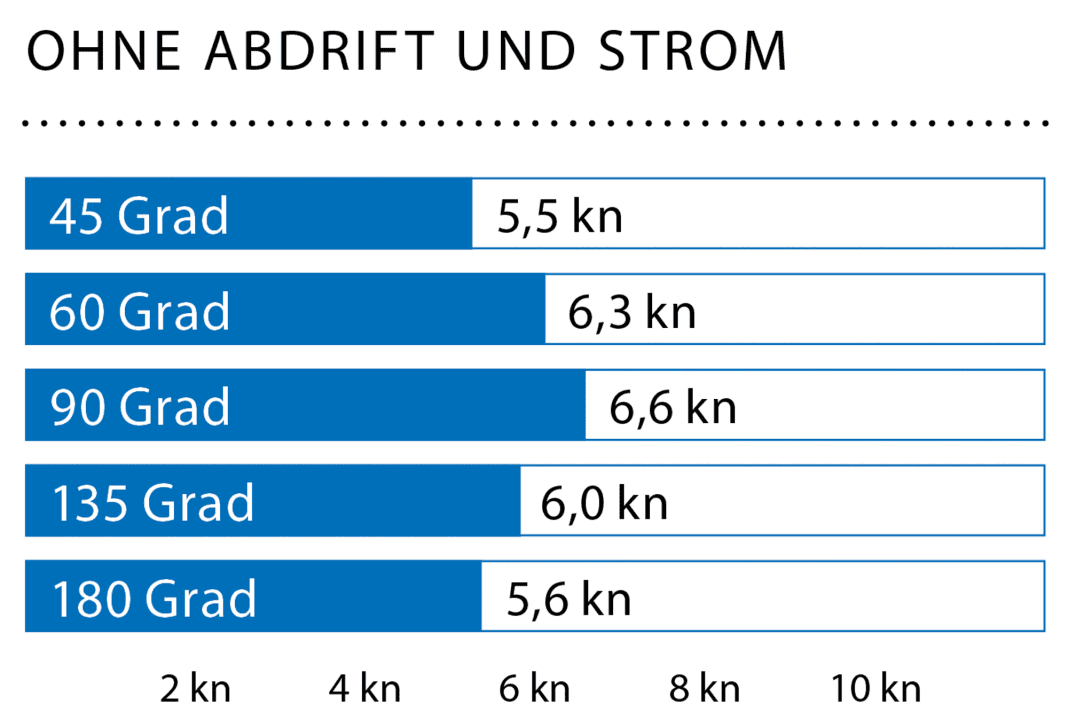



The Bavaria 30 Plus in detail
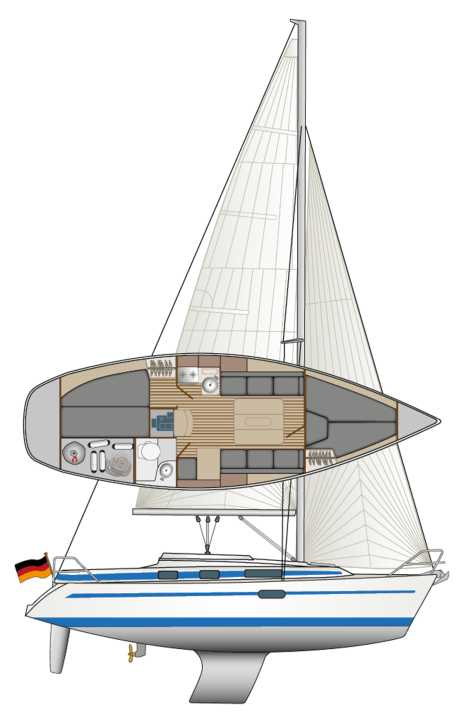
Technical data of the Bavaria 30 Plus
- Designer: J&J Design
- Construction supervision: Lloyds 100-A5
- Total length: 9,25 m
- Width: 2,95 m
- Draught/alternative: 1,42/1,05 m
- Weight: 3,3 t
- Ballast/proportion: approx. 1 t/30 %
- Mainsail: 19,5 m2
- Furling genoa (120 %): 21,7 m2
- machine (Yanmar): 13 kW/18 hp
Hull and deck construction
Polyester resin, hand lay-up method, outer layers with iso-resin. Foam core, solid E-glass in the keel area
Price and shipyard
- Base price ex shipyard 1992: 63.400 €
- Used price today: 30-49.000 €
- Built from/to: 1993-1996
- Quantity: unknown
As of 01/2024, how the prices shown are defined can be found here!
Shipyard
Bavaria Yachtbau GmbH, Giebelstadt
Distribution
Dealer network and brokers. www.bavariayachts.com
YACHT rating of the Bavaria 30 Plus
A pocket-sized family yacht. Well built and with good sailing characteristics. A good boat for smaller people. If possible, buy with a tiller and deep keel
Design and concept
- + Solid structure and floor assembly
- + Low draught possible
- - Control column position
Sailing performance and trim
- + Safe steering feel
- + Very well trimmable rig
Living and finishing quality
- + Plenty of light in the salon thanks to Skylight
- + High-quality timber construction
- - Bunk dimensions and headroom too small
Equipment and technology
- + Powerful traveller
- + Redirected traps
- - Sprayhood interferes with cranking
Keep your eyes open when buying Bavaria
Most problems are caused by leaks. With a little manual dexterity, you can fix them yourself. Otherwise, the Bavaria is very solid.
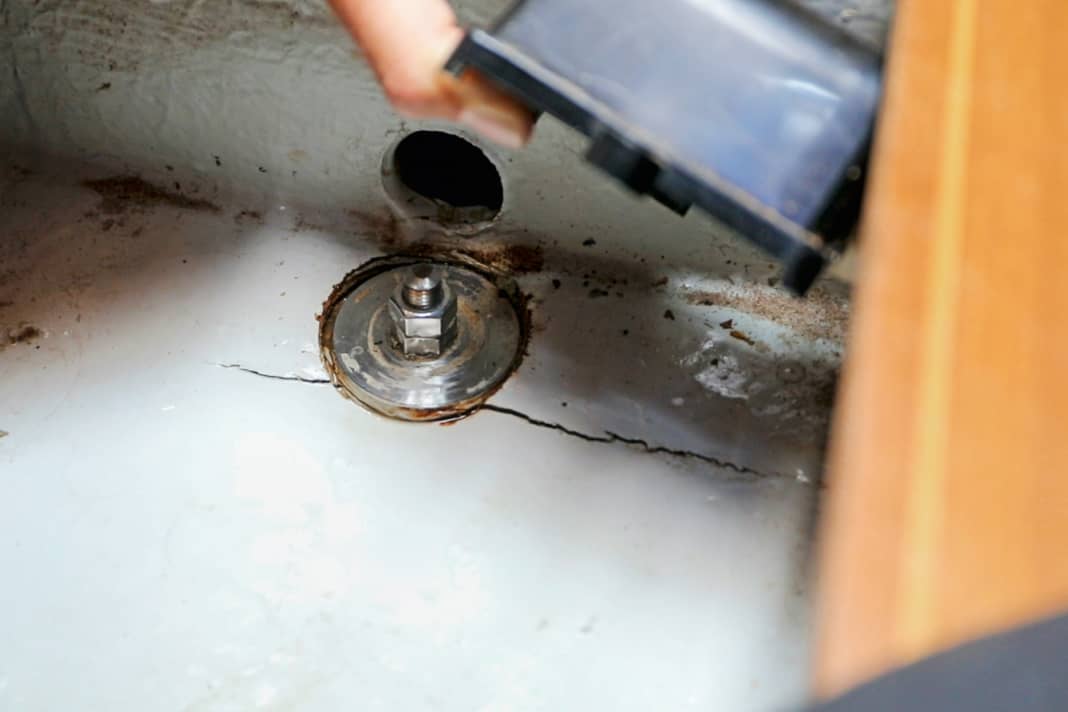





Video of the Bavaria 30 Plus
This article first appeared in YACHT 22/2021 and has been updated for this online version.
More used boat tests:
- Used boat test Lagoon 410: What can the pioneer of large series catamarans do?
- Oceanis 361 as a used boat: Solid cruising yacht from the large series
- Used boat test: Compromis 777, 888 and 999 in comparison
- Aphrodite 101: Fast daysailer with limited interior space in a used boat test
- Used boat test: Sirius 31 - the designer's last dream

